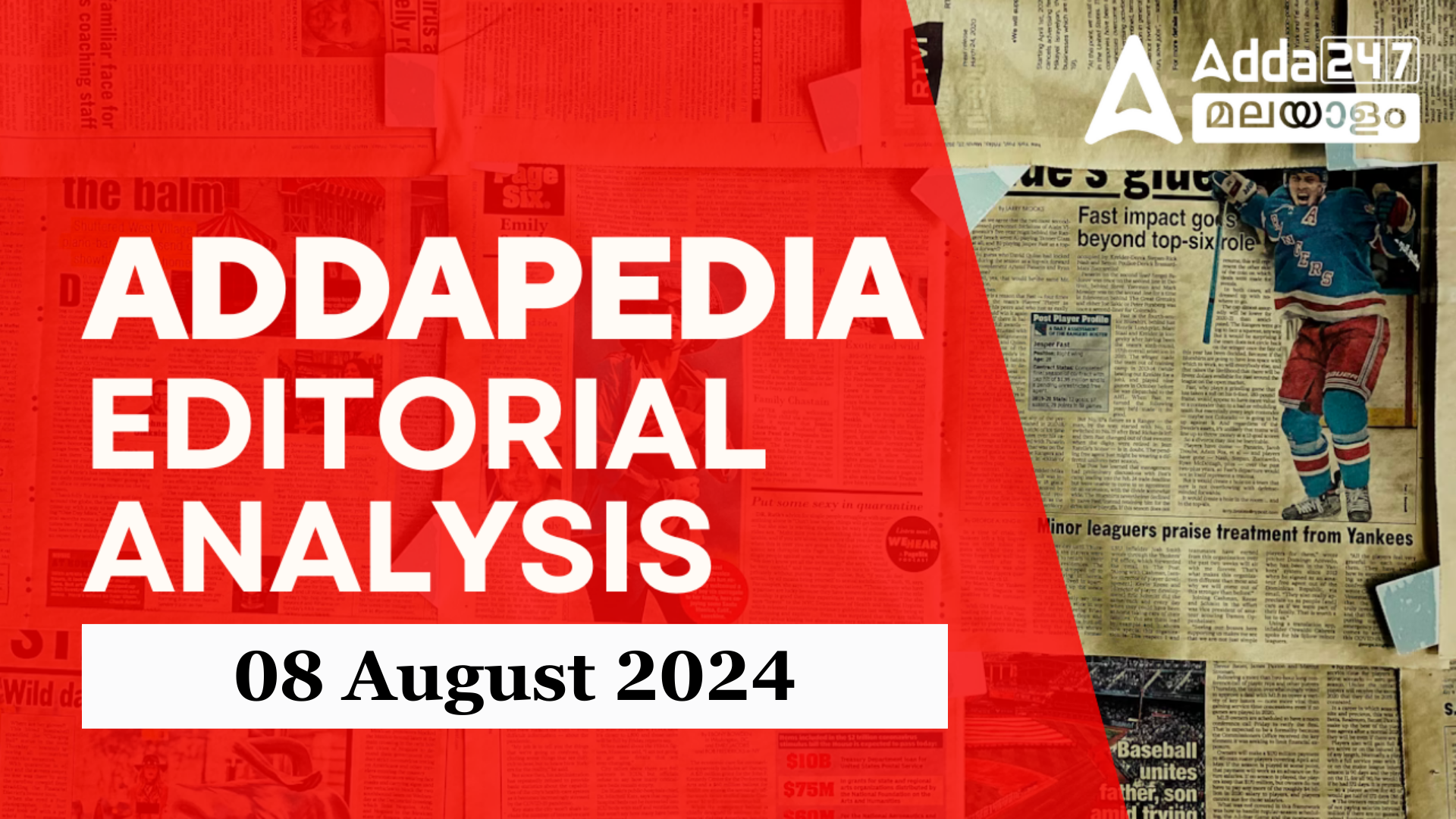Table of Contents
Addapedia Editorial Analysis: Daily News Editorial Analysis 08 August 2024
Addapedia Editorial Daily News , 08 August 2024: In this Addapedia Editorial Analysis, We cover Important News Editorials from Newspapers and provide you with detailed analysis. This ADDAPEDIA Editorial Analysis will help you in understanding the National and International events Current affairs and the background of a particular topic. This comprehensive News analysis will help you in Clearing CA and Interview for many exams.
Editorials usually cover a particular topic that might be National, State or any International event which is most important to acquire brief knowledge about the event. Editorials are written by Famous news analysts, Politicians, Business analysts, Civil Servants or a person who has immense knowledge in that particular field. Knowing Editorials will not only understand the geo-political relations but also how to write and describe any particular issue which helps especially in PSC, SSC and Banks Exams.
Under Overlords
(The Hindu, 08-08-24)
The Supreme Court ruled that the Lieutenant Governor (L-G) of Delhi has independent authority to appoint aldermen to the Delhi Municipal Corporation.
- This decision is not based on the advice of Delhi’s Council of Ministers.
What are aldermen and what is their role?
- Aldermen are members of municipal councils.
- They can be elected or appointed, depending on the jurisdiction. In Delhi specifically, aldermen are nominated by the Lieutenant Governor to provide expertise in municipal administration.
- Their primary functions include policy-making, representing constituents, and participating in local governance decisions.
What is the legal basis for the L-G’s power in this matter?
- The power stems from the Delhi Municipal Corporation Act, 1957, as amended in 1993.
- This Act identifies different authorities with distinct roles, including the L-G’s power to nominate persons with special knowledge in municipal administration.
How does this ruling relate to previous judgments on Centre-Delhi relations?
- It aligns with earlier judgments that sought to balance the roles of the elected government and the appointed administrator.
- A 2018 Constitution Bench had laid down a framework to avoid escalation of issues between the L-G and the Chief Minister.
What are the broader implications of this ruling for Delhi’s governance?
- It underscores the vulnerability of Delhi’s elected government to central control.
- It raises questions about the relevance of having an elected Assembly for Delhi.
- It highlights that the Centre ultimately has the final say in Delhi’s governance.
- The ruling may further strain the relationship between the Centre and Delhi’s elected government, potentially impacting policy implementation and governance in the national capital.
Can you answer the following question?
The governance structure of the National Capital Territory of Delhi presents a unique challenge in balancing local autonomy with national interests.Comment.
Middle Income Trap
(The Hindu, 08-08-24)
What is the middle-income trap?
The middle-income trap refers to a situation where a country that has achieved middle-income status struggles to progress further to become a high-income economy. This economic development phenomenon typically occurs when a country’s growth slows down after reaching middle-income levels.
Key aspects of the middle-income trap include:
- Economic slowdown: Countries experience rapid growth as they transition from low to middle income, but then see growth rates plateau.
- Difficulty in transitioning to innovation based growth: These countries find it challenging to shift from resource-driven growth to innovation-driven growth.
- Wage competition: They become less competitive in labor-intensive industries compared to lower-wage economies but struggle to compete with advanced economies in high-skill innovations.
- Productivity issues: Often, there’s a failure to significantly improve productivity and move up the value chain in manufacturing and services.
- Institutional challenges: Middle-income countries may lack the institutional quality and economic complexity needed for further advancement.
- Human capital limitations: There may be insufficient investment in education and skills development to support higher-value industries.
Countries often cited as examples of being in or having escaped the middle-income trap include Malaysia, Thailand, and Brazil (often considered trapped) versus South Korea, Singapore, and Taiwan (examples of countries that have successfully transitioned to high-income status).
Is India in a situation of being Middle-Income trapped?
Arguments suggesting India may be in a middle-income trap:
- Slow transition to high-value industries:
- India’s manufacturing sector contributes only about 15% to GDP (as of 2022), lower than many other developing countries.
- The services sector, while strong in IT, hasn’t diversified sufficiently into other high-value areas like AI & Machine learning.
- Productivity challenges:
- Total factor productivity growth has slowed from 2.4% per annum during 2003-07 to 0.9% during 2013-19 (Source: Reserve Bank of India).
- Income stagnation:
- India’s GDP per capita (PPP) growth rate has slowed from an average of 7.5% during 2000-2010 to about 5.5% during 2010-2020 (World Bank data).
- Human capital limitations:
- As of 2022, only about 27% of Indians aged 18-23 are enrolled in tertiary education (Ministry of Education, India).
- Income inequality:
- India’s Gini coefficient (a measure of income inequality) was 35.7 in 2019, indicating significant disparity (World Bank).
Arguments against India being in a middle-income trap:
- Consistent economic growth:
- India has maintained an average GDP growth rate of around 6-7% over the past decade, despite global economic challenges.
- Post COVID-19 pandemic, India’s economy has rebounded and has shown resilience.
- Digital transformation:
- India’s digital economy is projected to reach $1 trillion by 2025 (Ministry of Electronics and Information Technology).
- The country has over 750 million internet users as of 2023, indicating potential for further digital-led growth.
- Young demographic:
- India has a median age of 28.4 years (2021), providing a potential demographic dividend for future growth.
- Rising foreign direct investment (FDI):
- FDI inflows have been consistently increasing, reaching $84.8 billion in FY 2021-22 (Department for Promotion of Industry and Internal Trade).
- Expanding startup ecosystem:
- India has the world’s third-largest startup ecosystem, with over 100 unicorns as of 2023 (Invest India).
What precautions should India take to avoid this trap?
- Boost manufacturing and industrial policy
- Focus on high-value manufacturing sectors like electronics, pharmaceuticals, and advanced materials.
- Improve education and skill development:
- Increase spending on education (currently around 3% of GDP) to at least 6% as recommended by various education commissions.
- Strengthen industry-academia partnerships to ensure curriculum relevance.
- Expand vocational training programs to address the skills gap in the job market.
- Promote R&D and Infrastructure
- Increase R&D expenditure from the current 0.7% of GDP to at least 2% (closer to levels in innovation-driven economies).
- Continue to invest in physical infrastructure (roads, ports, airports) to reduce logistics costs.
- Improve ease of doing business:
- Further streamline regulations and reduce bureaucratic hurdles.
- Implement labor reforms to increase flexibility while ensuring worker protection.
- Simplify tax structures and improve tax administration.
- Improve healthcare:
- Increase healthcare spending from the current 1.8% of GDP to at least 2.5-3%.
- Focus on preventive healthcare and improving rural healthcare infrastructure.
- Expand health insurance coverage to reduce out-of-pocket expenses.
- Diversify the economy:
- Reduce dependence on any single sector by promoting growth across multiple industries.
- Encourage the development of new service sectors beyond IT, such as financial services, healthcare, and creative industries.
- Enhance energy security and sustainability:
- Accelerate the transition to renewable energy sources.
- Improve energy efficiency across industries and in urban planning.
Can you answer the following question?
India’s rapid economic growth has propelled it into the middle-income category, but concerns about falling into the ‘middle-income trap’ persist. Critically examine the challenges India faces in avoiding this trap and suggest comprehensive strategies to ensure sustained economic progress towards becoming a high-income economy.
Addapedia Editorial Analysis PDF 08 August 2024 – Download Link
കേരളത്തിലെ എല്ലാ മത്സര പരീക്ഷകൾക്കും ഓൺലൈൻ ക്ലാസുകൾ, വീഡിയോ കോഴ്സുകൾ, ടെസ്റ്റ് സീരീസ്, പുസ്തകങ്ങൾ, മറ്റ് പഠന സാമഗ്രികൾ എന്നിവ ചുവടെ നൽകിയിരിക്കുന്ന ലിങ്കിൽ ക്ലിക്കുചെയ്ത് കണ്ടെത്താനാകും.
***വരാനിരിക്കുന്ന പരീക്ഷകളിൽ വിജയിക്കാൻ ഞങ്ങളോടൊപ്പം ചേരുക***
*ലക്ഷ്യത്തിലേക്കുള്ള ആദ്യ ചുവടുവെപ്പ് | ADDA247 മലയാളത്തിൽ പരിശീലനം ആരംഭിക്കൂ*
Adda247 Malayalam Youtube Channel |
Telegram group:- KPSC Sure Shot Selection




